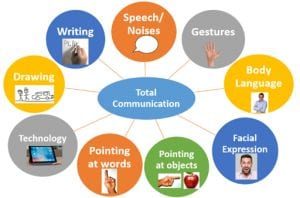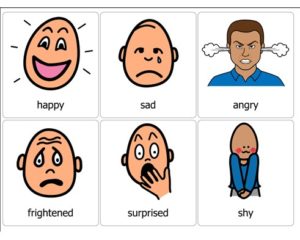Overview:
Total communication is the popular approach that encourages deaf children to use both spoken (oral) and manual (signed) language. Or less formerly, this philosophy suggests that a child should use all methods of communication that are accessible and will best support the child in acquiring language. Most commonly, this includes the interaction between spoken and sign languages (Simultaneous-Communication, or Sim-Comm), but it may also involve cued speech, finger spelling, lip reading, facial expressions, and many more. Note that even with TC, students often wear their respective hearing devices for optimal communication options.

Pros and Cons:
Pros:
- This approach can adapt over time, and you may use whatever method your child prefers, even if they are learning more than one.
- Methods can be combined or changed.
- Usually provides teaching in both visual and spoken language. Many consider this to result in the most proficient language for deaf children.
- Children learn to interact in both the Deaf and hearing worlds, allowing for optimal exposure to language as well as social development.
- Allows for the most expressive potential.
- Allows for better transition into hearing environment such as a hearing grade school, or even college.
- Emphasis on communication, not a particular method of communication. Child has the freedom.
Cons:
- May limit child’s language exposure in the long run, as they may never be exposed to complex language or complex sign. Instead, they use intermediate levels of both.
- Not as useful for profoundly deaf students, as they lack access to spoken language compared to mildly deaf or hard of hearing students.
- Goals of broad language skills in several modes of communication may result in difficulty attaining fluency in one method.
- Total communication in group settings where one student prefers a certain method may leave the student feeling left out if the instructor is communicating in another method.
Total Communication and Promoting Language:
The duality (or more) allows for the expansion of language beyond a single mode of communication. Where a child may lack expertise in one method, they can make up for through knowledge in another¹. Or, the simultaneous use of signed and spoken language (or any two simultaneous methods) allows for reinforcement of ideas and improved abilities in reception and expression. As the goal with Total Communication is to employ whatever methods provides the child the best chances for language proficiency, success varies depending on the methods used. However, any optimal combination of methods will support the student’s language development in:
- Receptive and Expressive Language
- May be apparent in any method
- Vocabulary – even if it involves code switching or switching between languages. The goal is let the child have a voice or manner of expressing themself
- Grammar – may be different between languages, resulting in relative success in two unique grammatical systems (ex. ASL and spoken English)
- Social cues associated with conversation that may not be learned with solely one language or method
Total Communication in the Classroom:
As Total Communication classrooms often take on the Simultaneous-Communication form of signed and spoken languages, education in these environments emphasize language acquisition through both methods at the same time. While I cannot describe every combination of one sign and one spoken language, a common one is a manually coded sign like SEE and spoken English.
This approach doesn’t differ much from oral therapy in terms of what a typical classroom may look life – the key difference is that the students express themselves in several manners.
One TC classroom I’ve witnessed maintained the familiar circle technique. As each student introduced themself to me, they chose either to sign or speak it. Afterwards, they had the option to do it again, but in the other language. This allowed the children to communicate in the way they found preferable, but also to build upon their linguistic knowledge by incorporating another means of conveying the same information². Later, the students were presented with a toy set including a barn and some farm animals. They were asked to share a short, imaginative story about the animals of their choice. However, if they did not know the word for something in their story, they had to express it another way. Since each child had various knowledge in either language, almost each animal had been named in both sign language and speech by the end of the rotation. Even if one child had a preference for one method, they were still learning language in another and improving their understanding.
Naturally, each classroom varies and the example only signifies one way in which the communication methods may complement another, but Total Communication in the educational setting typically mirrors that in that the use of language in whatever form is encouraged but not forced. This approach maintains popularity in that children have a sense of freedom³, still get to enjoy all classroom activities, and the comprehensive use of language demonstrates gains in language, cognition, and social experience.
Sample Activity:
A simple means of allowing access to more than one means of communication in an activity or lesson is to quite literally have another approach at hand.
For example, in teaching vocabulary for emotional expressions, encourage deaf students to speak or sign the prompted expression, then have them indicate the corresponding facial expression on a low tech AAC picture board. Not only does this aid in adding another potential manner of conveying a message of emotion, if the child signs ASL then the facial expression may strengthen their knowledge of the sign.

Notes:
1- Transfer; Transfer is the ability to use what is learned in one situation in a novel situation. This can be seen in the way children in total communication classrooms may shift what they’ve learned about language between methods of communication. For example, the transfer of the English grammatical system first learned in SEE to the reading and writing process.
2 – A method for promoting transfer in student: Presenting key concepts and procedures in multiple forms and varying contexts; This method entails revisiting fundamental concepts often and in diverse ways. Using several procedures to reach a goal promotes reflection and analysis required for transfer. In the Total Communication philosophy, using diverse means for communicating is exactly the goal, and aids in transferring knowledge of language and its accompanying components across methods of communication. The same idea can be seen in another transfer strategy – Creating a learning environment that supports the sociocultural dimensions of transfer. Once again, this is exactly what TC stands for, allowing students to employ ideas in new ways to make themselves understandable. This means teachers must be prepared to support the open exchange of ideas.
3 – Initiative; Initiative is the aspect of Erikson’s Psychosocial Development that puts forth that preschoolers attempt to explore their independence through self-initiated tasks and choices. If adult expectations for control are too high, children may experience frustration. In a Total Communication classroom, the emphasis in placed on a child’s right to choose how they wish to communicate. This freedom, when violated by teachers enforcing a specific method, can result in frustration because a child cannot effectively communicate in that method or prefers not to do so.
